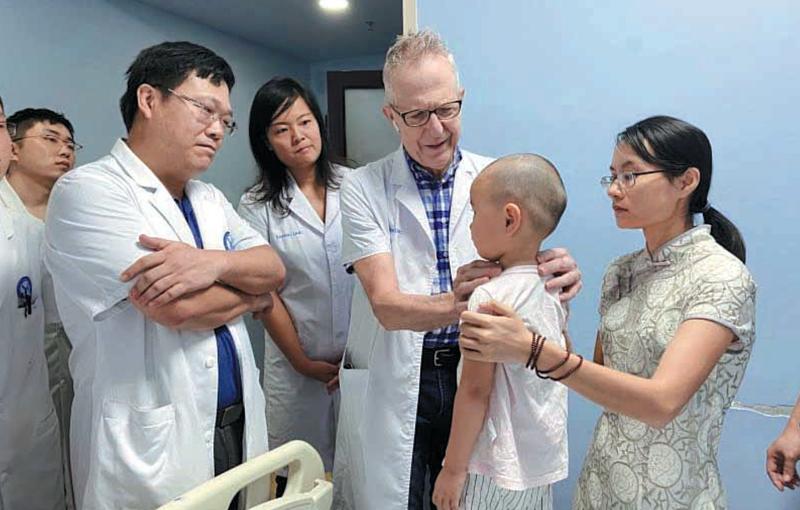US surgeon returned to treat Chinese children with cerebral palsy
 David Price Roye Jr. and his colleagues check a child's health at Shantou University's Guangzhou Huaxin Orthopedic Hospital in Guangzhou, Guangdong province. (PHOTO PROVIDED TO CHINA DAILY)
David Price Roye Jr. and his colleagues check a child's health at Shantou University's Guangzhou Huaxin Orthopedic Hospital in Guangzhou, Guangdong province. (PHOTO PROVIDED TO CHINA DAILY)
On Feb 20, as the country faced an uphill battle to control the COVID-19 pandemic, prominent United States surgeon David Price Roye Jr. realized the need to keep treating Chinese children with cerebral palsy.
An emeritus pediatric orthopedic surgeon at Columbia University Medical Center in New York, Roye flew to Beijing via Tokyo as direct flights between China and the US were being suspended.
It was Roye's 79th visit to China in 23 years. In the past, he has joined tours arranged by the Children of China Pediatrics Foundation, a nonprofit organization devoted to providing medical treatment for children with disabilities and deformities living in Chinese orphanages, and exchanged medical information with local health workers.
I love being here. I love knowing that week by week, month by month, year by year, I’m here
David Price Roye Jr., US surgeon and an academic consultant at Shantou University’s Guangzhou Huaxin Orthopedic Hospital in Guangdong province
The International Healthcare Leadership program he established 14 years ago has provided visiting fellowships in US cities for Chinese physicians. Roye works as an academic consultant at Shantou University's Guangzhou Huaxin Orthopedic Hospital in Guangzhou, Guangdong province.
"I want to do something that I really want to do. I really want to be here in China. I want to be making a difference for children with cerebral palsy, trying to help my colleagues build a stronger subspecialty in pediatrics with pediatric surgery," he said.
Roye said when he arrived in China two decades ago there was no specialist area of pediatric orthopedics. "Now there is a field and there are meetings," he said. "I just attended the 2020 pediatric orthopaedic annual meeting of the orthopedic branch of the Guangdong Medical Doctor Association in Dongguan. It was a very academic, very solid meeting. However, there are not nearly enough people (in this field) in China, not even close."
Roye is helping the hospital explore new medical areas, such as correcting children's spinal deformities.
Li Xu, deputy president and director of the hospital's pediatric orthopedic department, said some surgeries Roye performs are rarely done in China, such as those for neuromuscular diseases like cerebral palsy. In 2018, it was estimated that about 50,000 babies in China were born with cerebral palsy, Li said.
Bone deformities associated with the neuromuscular disorder present the most difficult medical challenge. Cerebral palsy is more difficult to treat in children than in adults because of the changes they undergo as they grow.
"Doctor Roye performs surgeries, sees patients and participates in the discussion of every case. Our team is one of the top ones in South China so we have many complicated cases," Li said.
The South China Center for Childhood Disabilities and an advanced cerebral palsy gait lab, a facility that uses computer technology to capture a 3D image of a child's walk, were unveiled at the hospital in August.
Roye said the cerebral palsy gait lab meant the establishment of a "real CP center with multidisciplinary care, establishing a robust foundation for a clinical research program here". He said he wanted to help establish a "clinical fellowship" for pediatric orthopedics surgery, while maintaining his role in caring for children. "In all of this I don't want to forget my clinical role. I take care of kids and I love being in the operating room," he said.
A typical morning for Roye starts at 7 am or 7:30 am with a teaching conference, where the clinical staff read English-language medical literature and textbooks and translate them into Chinese. This is followed by comments from Roye and questions from staff members.
There is also a morning conference on the conditions of patients, which also provides teaching opportunities. "It's not just reviewing the patients, but it's for the practical issue of patient care," Roye said. "We'll sometimes spend 10 or 15 minutes on one particular patient because the issues demand that kind of time."
For most of the remainder of his day at the hospital, Roye is in the operating theater. He also works on medical articles and his own correspondence. "I have a busy correspondence exchange with the US.But it doesn't keep me at work late, so I get home about six," he said.
Despite the high-pressure work, Roye said the job is its own reward.
"I love being here. I love knowing that week by week, month by month, year by year, I'm here," he said.
"I can start projects and finish them. I can tell my patients 'I'll see you in six months'. It's all good."
Liu Xiaolin in Guangzhou contributed to this story.


